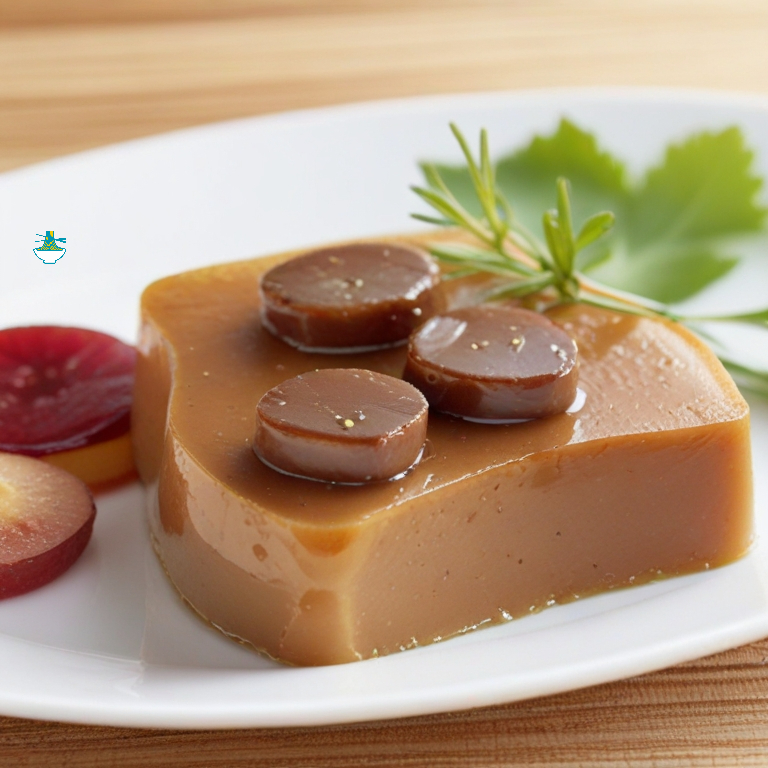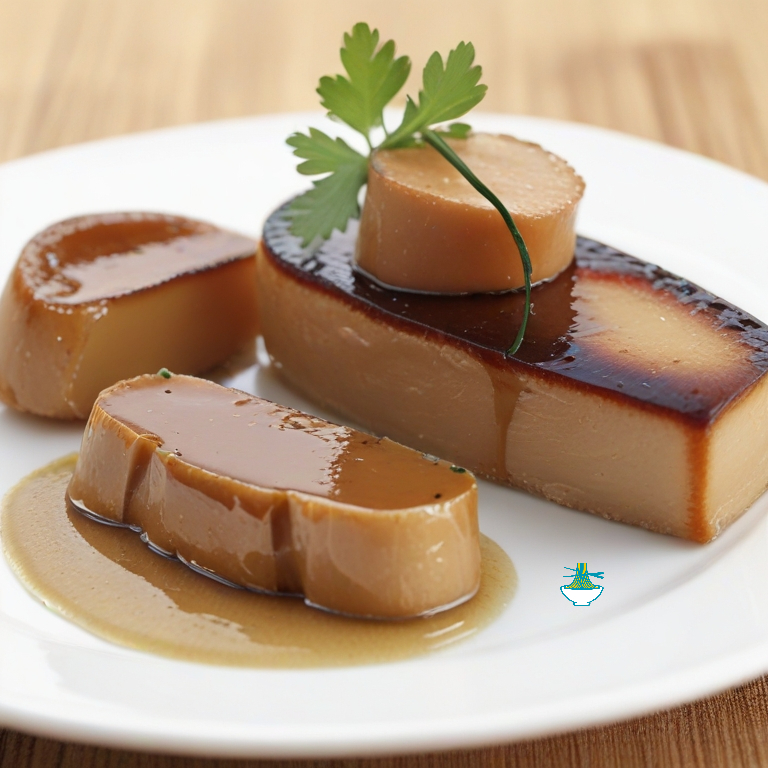Indulge in the epitome of culinary sophistication with France's renowned Foie Gras. Delight your senses with this exquisite delicacy, meticulously crafted from the finest duck or goose liver. Renowned for its rich, buttery texture and complex, indulgent flavor, France's Foie Gras represents centuries of gastronomic tradition. Elevate any occasion with its unparalleled taste, whether served as a decadent appetizer, a luxurious accompaniment, or the centerpiece of a gourmet feast. Experience the artistry and savoir-faire of French culinary heritage with each sumptuous bite of Foie Gras.
Ingredients:
- 1 whole duck or goose liver (about 500g)
- 1 tablespoon kosher salt
- 1/2 teaspoon freshly ground black pepper
- 1/4 teaspoon ground white pepper
- 1/4 teaspoon ground nutmeg
- 1/4 teaspoon ground cloves
- 1/4 teaspoon ground ginger
- 1/4 teaspoon ground cinnamon
- 2 tablespoons Armagnac or Cognac (optional)
- 1 teaspoon sugar (optional)
- Quality coarse sea salt, for curing

Instructions:
1- Prepare the Foie Gras: Begin by carefully separating the lobes of the liver, removing any veins or connective tissues. Place the lobes in a bowl of cold water and let them soak for about 30 minutes. This helps to remove any excess blood.
2- Drain and Season: After soaking, gently pat the liver dry with paper towels. In a small bowl, mix together the kosher salt, black pepper, white pepper, nutmeg, cloves, ginger, and cinnamon. Rub the spice mixture evenly over the surface of the liver. If desired, drizzle the Armagnac or Cognac over the liver and sprinkle with sugar.
3- Shape and Cure: Lay a piece of plastic wrap on a clean work surface. Place one lobe of the seasoned liver on the plastic wrap. Gently fold the edges of the plastic wrap over the liver to form a neat, compact package. Repeat with the remaining lobe(s). Place the wrapped liver(s) in a shallow dish and refrigerate for 24 to 48 hours to allow the flavors to meld and the liver to cure.
4- Prepare for Cooking: After curing, remove the liver from the refrigerator and unwrap it. Let it come to room temperature for about 30 minutes before cooking. Preheat your oven to 180°C (350°F).
5- Sear the Foie Gras: Heat a skillet over medium-high heat. Once hot, carefully place the liver in the skillet. Sear each side for about 1 minute, until golden brown. Be gentle when flipping the liver to prevent it from breaking apart.
6- Transfer to Oven: Once seared, transfer the liver to a baking dish or oven-safe skillet. Place it in the preheated oven and bake for 10 to 15 minutes, or until the foie gras is heated through and slightly softened. Be cautious not to overcook, as foie gras can become tough if cooked for too long.
7- Rest and Serve: Remove the foie gras from the oven and let it rest for a few minutes before serving. Sprinkle with a pinch of coarse sea salt for added flavor. Serve slices of foie gras on toasted bread or brioche, accompanied by a sweet fruit compote or lightly dressed salad.
8- Enjoy: Indulge in the luxurious flavors and velvety texture of this classic French delicacy, savoring each decadent bite. Bon appétit!
Nutritional Values:
Duck or Goose Liver (per 100g):
- Calories: 500-700 kcal
- Protein: 15-20g
- Fat: 45-60g
- Saturated Fat: 15-20g
- Cholesterol: 400-600mg
- Carbohydrates: 0g
- Fiber: 0g
- Sodium: 100-150mg
- Iron: 6-10mg
- Vitamin A: 3000-5000 IU
- Vitamin C: 0mg
- Calcium: 5-10mg
benefits
- Rich source of protein, essential for muscle growth and repair.
- High in healthy fats, including omega-3 fatty acids, which support heart health and brain function.
- Contains significant amounts of iron, crucial for red blood cell production and oxygen transport in the body.
- Good source of vitamin A, necessary for vision, immune function, and skin health.
Kosher Salt (per teaspoon):
- Calories: 0 kcal
- Sodium: 2300mg
benefits
- Enhances flavor without adding extra calories.
- Helps to balance and enhance other flavors in the dish.
- Aids in food preservation and can help draw out moisture from ingredients.
Black Pepper (per teaspoon):
- Calories: 6 kcal
- Protein: 0.3g
- Fat: 0.1g
- Carbohydrates: 1.5g
- Fiber: 0.6g
benefits
- Contains antioxidants that help protect cells from damage caused by free radicals.
- Supports digestion by stimulating the production of digestive enzymes.
- May have anti-inflammatory properties and promote gut health.
White Pepper (per teaspoon):
- Calories: 5 kcal
- Protein: 0.2g
- Fat: 0.1g
- Carbohydrates: 1.1g
- Fiber: 0.5g
benefits
- Similar benefits to black pepper, but with a milder flavor profile.
- Contains compounds that may help improve digestion and reduce bloating.
- Can act as a natural antimicrobial agent.
Spices (per teaspoon, combined):
- Calories: Varies (negligible)
- Depending on the spice used, there may be small amounts of vitamins and minerals, but these would contribute minimally to the overall nutritional value.
benefits
- Each spice (nutmeg, cloves, ginger, cinnamon) may have its own unique health benefits, including antioxidant properties, anti-inflammatory effects, and digestive support.
- Together, they add depth of flavor and aromatic complexity to the dish.
Armagnac or Cognac (per tablespoon):
- Calories: 64-70 kcal
- Carbohydrates: 1-2g
benefits
- Adds depth and complexity to the flavor profile of the dish.
- Contains certain antioxidants that may offer health benefits in moderation.
- Can contribute to a sense of warmth and richness in the final dish.
Sugar (per teaspoon):
- Calories: 16 kcal
- Carbohydrates: 4g
benefits
- Adds sweetness to balance the savory and rich flavors of the dish.
- Provides quick energy for the body, though it should be consumed in moderation.
- Enhances the caramelization process during cooking, adding depth of flavor and color to the final dish.
Please note that these values are approximate and can vary based on factors such as brand, cooking methods, and specific ingredients used. Additionally, foie gras is known for being high in fat and cholesterol, so it's often consumed in moderation as part of a balanced diet.


Comments